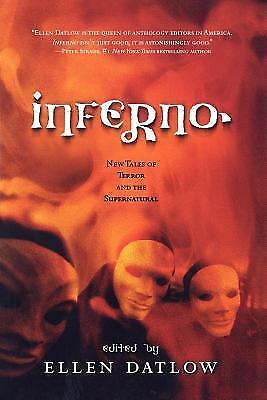 Edited By ELLEN DATLOW (Tor; 2007)
Edited By ELLEN DATLOW (Tor; 2007)
This anthology, now available in trade paperback, has garnered much praise since its 2007 debut, and for once all the shouting is justified. Composed of twenty never-before published stories, INFERNO really is one of the finest horror story collections on the market, with a diversity of writing talent and subject matter that remain unprecedented, if not unmatched. Even better, the authors collected here achieve their scares without resorting to genre standbys like vampires, werewolves, witches or zombies.
Ellen Datlow is known for editing classy collections like THE DARK, THE COYOTE ROAD and the Year’s Best Fantasy and Horror series. For INFERNO (originally supposed to be called DATLOW’S INFERNO) Datlow grouped top names like Pat Cadigan, Christopher Fowler, Stephen Gallagher and Lucius Shephard together with lesser known talents like Nathan Ballingrud, Paul Finch and Simon Bestwick, and even coaxed a story out of the reclusive K.W. Jeter.
It’s Jeter’s piece, “Riding Bitch,” that begins the collection, and in memorable fashion, with a depressed crematorium owner finding himself handcuffed to a dead woman. Gallagher’s “Misadventure” follows, a more subtle tale of a haunted pool. Laird Barron’s “The Forest” is similarly low-key in its approach, although the impact is anything but. Joyce Carol Oates contributes “Face,” a short but resonant mood piece about an old woman with a disquieting growth on her neck. Shephard’s “The Ease with Which we Freed the Beast” takes a seemingly straightforward, even clichéd, premise—a bunch of young punks release an ancient horror from its confinement—and pulls it off in wholly unpredictable fashion.
That’s not to say all the stories are of the quiet variety. Lee Thomas’s “An Apiary of White Bees” is a gruesome and explicit account of a hotel owner assailed by a peculiarly sexual horror involving bees, and Simon Bestwick’s “Hushabye,” about a hunt for a child killer, contains some profoundly disquieting imagery.
Favorites? Ballingrud’s “The Monsters of Heaven” is a mind-blower, and easily one of the book’s standout entries. Ever hear the old saying “It’s dangerous to mistake children for angels?” This tale gives that phrase unforgettable form. I also appreciated Fowler’s “The Uninvited,” a haunting account of the late 1960s Hollywood party scene, and an encounter with four uninvited partygoers whose true-life identities (known to us all) are revealed on the final page. “Bethany’s Wood” by Paul Finch is another standout, an arrestingly bizarre account involving malevolent automatons.
As for those stories that didn’t affect me all that much…Cadigan’s “Stilled Life” contains a terrific premise involving human statues but fails to fully capitalize on it. “The Janus Tree” by Glenn Hirschberg is a rambling coming-of-age saga darkened by an ill-defined supernatural menace (read Graham Joyce’s THE TOOTH FAIRY to see what this story could have been). “The Suits at Auderlyne” by Terry Dowling, involving a crashed meteorite, a forbidding mansion and a missing suit of armor, once again begins promisingly only to fizzle out.
Yet all of INFERNO’S tales are startling and unpredictable, even if they weren’t all to my liking. This makes for a landmark volume in the genre, equal to classic anthologies like DARK FORCES, MASTERS OF DARKNESS and PRIME EVIL, and required reading for any true horror connoisseur.
